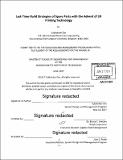| dc.contributor.advisor | Bruce C. Arntzen. | en_US |
| dc.contributor.author | Das, Subhankar | en_US |
| dc.contributor.other | System Design and Management Program. | en_US |
| dc.date.accessioned | 2017-10-30T15:29:49Z | |
| dc.date.available | 2017-10-30T15:29:49Z | |
| dc.date.copyright | 2017 | en_US |
| dc.date.issued | 2017 | en_US |
| dc.identifier.uri | http://hdl.handle.net/1721.1/112062 | |
| dc.description | Thesis: S.M. in Engineering and Management, Massachusetts Institute of Technology, School of Engineering, System Design and Management Program, 2017. | en_US |
| dc.description | Cataloged from PDF version of thesis. | en_US |
| dc.description | Includes bibliographical references (page 49). | en_US |
| dc.description.abstract | Forecasting demand and managing spare part inventory has long been a challenge for products that have a very long lifecycle time. With demand being discrete, low and sporadic, understanding of the actual demand is erroneous and hence forecasting the right demand for a Last-Time-Build has been difficult. Managers routinely build buffer stock to avoid missing contractual agreements, with extremely high penalties for running out of stock. Thus, Last-Time- Build strategies have been expensive and non-profit yielding. With the advent of 3D printing technology and its superiority in terms of the ability to setup shop at a low cost and print parts as and when required, make it a very promising technology in solving the issue of spare part inventory management. In this thesis, a model-based approach was taken to the decision making of Last-Time-Build. By use of financial modeling and non-linear optimization tools, optimal strategies to best use 3D printing technology have been recommended, under several conditions of demand uncertainty. The most optimal results are achieved when a Hybrid approach is employed. The Hybrid approach is a combination of a Last-Time-Build via traditional manufacturing method that is supplemented with parts printed via 3D printer, to cater to changing demand, at a future point of time. The model helps in determining the best combination of parts that need to be built ahead and the parts that can be built later via 3D printing for various demand projections and a given service level that needs to be met. The sensitivity of each of the different variables involved on the decision making is also highlighted. The higher the uncertainty in demand, the more lucrative is the hybrid approach to solving the problem of spare part inventory management. | en_US |
| dc.description.statementofresponsibility | by Subhankar Das. | en_US |
| dc.format.extent | 49 pages | en_US |
| dc.language.iso | eng | en_US |
| dc.publisher | Massachusetts Institute of Technology | en_US |
| dc.rights | MIT theses are protected by copyright. They may be viewed, downloaded, or printed from this source but further reproduction or distribution in any format is prohibited without written permission. | en_US |
| dc.rights.uri | http://dspace.mit.edu/handle/1721.1/7582 | en_US |
| dc.subject | Engineering and Management Program. | en_US |
| dc.subject | System Design and Management Program. | en_US |
| dc.title | Last-time-build strategies of spare parts with the advent of 3D printing technology | en_US |
| dc.type | Thesis | en_US |
| dc.description.degree | S.M. in Engineering and Management | en_US |
| dc.contributor.department | Massachusetts Institute of Technology. Engineering and Management Program | en_US |
| dc.contributor.department | System Design and Management Program. | en_US |
| dc.identifier.oclc | 1006730679 | en_US |
